| Design by Michael Storer -
Oz |
By now just
about everyone knows that Michael Storer and
Peter Hyndman have taken Shorty's PDRacer concept
and produced a set of plans
to build a lightweight, high performance version
called the Oz
PDRacer. Anyone thinking of building
a PDRacer should seriously consider a set of
these plans. The following are some thoughts
Michael jotted down not long ago. - Chuck |
I thought I would write a bit of a spiel about how
the little boats are going. We (and several other
people) have been sailing them over the last few days.
The performance is pretty much how I expected when
I drew up our version. In light winds they move along
really nicely - as you can see from the videos
which were all filmed in under 8 knots of breeze.
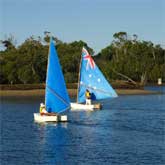 |
In light
winds they move along really nicely!
(click
images to enlarge) |
|
We had decided to put heaps of sail on them 80sq
ft vs the more normal 60 sq feet - the rules restrict
the hullshape only. We wanted the performance to really
sparkle in the light stuff. As you can see from the
videos they steer pretty well
and are capable of turning in their own lengths -
far faster in fact than this sailor can move!
Planing
One of the points I wanted to prove is that the original
designer said that the boats wouldn't plane - and
that was the group opinion of the American Sailors.
A couple of days ago I went for a sail upstream in
the Mooloola River - spent a coupla pleasant hours
exploring and trying to make headway against the outgoing
tide in the light winds. In the end I gave up in one
particularly light area (lots of trees both sides
of the river - the tops were waving in a reasonable
breeze, but there was nothing at water level where
I needed it.
| A couple
of days ago I went for a sail upstream in
the Mooloola River - spent a coupla pleasant
hours exploring and trying to make headway
against the outgoing tide in the light winds. |
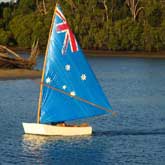
|
|
Anyway, headed back and the wind had picked up to
between 10 to 13 knots. This is the sort of wind speed
where I expected to start having problems from the
big rig. No Problems and on the upside got the boat
planing a couple of times in some of the stronger
gusts.
The main reasons for us being able to do it is that
our boats are about 1/3 the weight of the average,
they have lots of sail, they have carefully shaped
centreboards and rudders and though the sails are
made of polytarp the mast and boom and resulting sail
shape are quite efficient in light and moderate conditions
and downwind in these stronger breezes - though I
am not happy with the amount of stretch distortion
in the sails upwind in the stronger stuff.
Oh, yes - both Peter and I have a background in performance
sailing craft too - so we both know how to cajole
a boat onto a plane.
Holding together in stronger winds
The next day brought winds of around 10 to 15 knots
- so the peak of the gusts was greater than the previous
day. So I spent some time generally getting a feel
for the boat upwind and down.
I was worried
that the masts would be too weak because
of the poor grade of the timber, but they
have stood up so far.
|
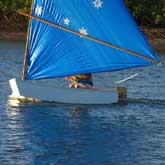
|
|
Upwind the boat points quite well sailing at close
to 45 degrees to the wind (that's those foils working).
In a gust the mast bends as it was designed to do
and spill some of the excess wind pressure automatically.
I was worried that the masts - junky floorboards
- would be too weak because of the poor grade of the
timber - but they have stood up so far. I was also
worried that the boats would become a handful in a
breeze - but in 15 knot gusts when they should be
well and truly starting to give us a hard time - no
probs at all.
Going fast
Reaching is where the fun starts - going across the
wind. As soon as there is enough wind pressure for
me to put my feet under the straps and start hiking
(not going for a walk with a backpack, but stretching
my body out from the side of the boat to keep it flat
and stop it from capsizing from wind pressure) - as
soon as there is enough wind to hike out on a reach
the boat planes efforlessly - at least in the smooth
water in front of Midge's.
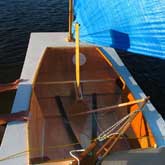 |
As soon
as there is enough wind pressure for me
to put my feet under the straps and start
hiking the boat planes efforlessly. |
|
The only thing that you have to remember is to move
about a foot further back just as you start hiking
to stop the bow digging in. If the bow digs in the
boat stops suddenly and is going too slow for the
rudder to be very effective. But if you hike and move
aft that little bit the boat accelerates, the bow
rises into the air mightily (that's all the excess
curvature of the bottom toward the back of the boat
starting to suck the stern down) and you are moving
along quite nicely.
Easy to sail
Almost anyone can jump in and have a great deal of
fun - they feel faster than they are and behave just
like little modern dinghies. They are not too hard
to hold up and with only one sail and the steering
to take care of they are simple.
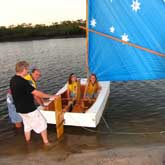 |
On launch
day one of the people there took his two
little girls out for a sail - he hadn't
sailed a keelboat or dinghy before - only
windsurfers - and he had no trouble at
all. |
|
On launch day one of the people there took his two
little girls out for a sail - he hadn't sailed a keelboat
or dinghy before - only windsurfers - and he had no
trouble at all.
Don from up the road dropped in the day after to
take one out for a sail. The last time he sailed a
small boat was when he was racing VJ dinghies about
30 years ago - he came back beaming.
These little boats are a hoot!
Rigging and unrigging
The other advantage is that they take about 5 minutes
(tops) to get ready to go sailing.
| They take
about 5 minutes (tops) to get ready to go
sailing. |
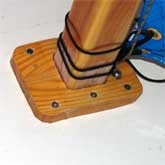
|
|
- Put hull upright.
- Drop mast in hole.
- Unwrap the sail from around the mast and stretch
it out.
One end of the boom is already attached at the back
end of the sail - but you have to thread the rope
on the other end through a pulley and then tie it
off around a cleat.
- Thread the mainsheet through two blocks
- Put the rudder in its housing.
- Put the elastic shock cord line on the centreboard
- Put the boat in the water and go sailing.
It's faster than me typing this.
For the performance minded
If there is anything "wrong" with the boats
it is the attention required to stay in the right
place fore and aft for whatever conditions you are
in. This will be one of the main skills required to
sail these boats efficiently when racing. When cruising
around it doesn't matter at all.
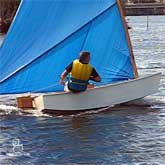 |
The PDRs
are very sensitive to fore and aft crew
placement - the huge curve of the bottom
makes them like a rocking horse.
|
|
The PDRs are very sensitive to fore and aft crew
placement - the huge curve of the bottom makes them
like a rocking horse. Move too far forward and you
can hear the bow starting to kick up water (in light
winds) or the sudden deceleration of the bow digging
in (in strong winds).
If you time the move aft so the bow doesn't dig in
the boat accelerates and the bow rises mightily -
so you can move close to your original position to
trim the boat a bit better for speed.
| Oz PDRacers
at the end of a day of great sailing! |
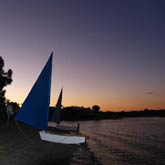
|
|
You can just sit in the back position all the time
but it means the boat will be going slower because
the stern is dragging in the water - you can see the
turbulence in the wake (turbulence always means lost
energy that could have been used to drive the boat
forward).
The optimum solution is just watch what happens and
move fore and aft as needed.
Best Regards
Michael Storer

to
order Oz PDRacer plans for $20 click HERE
|